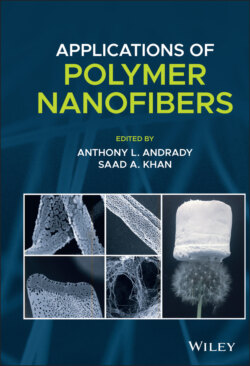Читать книгу Applications of Polymer Nanofibers - Группа авторов - Страница 42
2.3 Structure and Properties of Nanofiber Yarns
ОглавлениеThe structure of nanofiber yarns can be determined by either yarn deformation processing or yarn‐spinning technology, such as covering yarn, composite yarn, fancy yarn. It is important to note that the structure of yarns, which keeps a close relationship with yarns' properties, is influenced by various factors, including alignment, yarn evenness, twist levels, etc. Therefore, various examples regarding the structure and properties of nanofiber‐based yarns are discussed below.
Figure 2.6 Schematic images of (a) the fabrication process for nanofiber yarns and (b) devices of plying and twisting.
Source: Yan et al. (2016).
The structure of yarns is basically determined by the state of fibers within it, regarding the individual diameter and a total number of fibers, the cohesive force between fibers. Smit et al. designed and studied a nanofiber‐based yarn structure (Smit et al. 2005). The nanofiber yarns were prepared from PVAc, PVDF, and PAN by using a homemade setup. In the as‐prepared yarns, the average fiber diameters of PVAc, PVDF, and PAN strongly depended on the polymer concentrations. It is speculated in Figure 2.7 that the average yarn contained approximately 3720 fibers per cross‐section. Tian et al. investigated the influence of twisting level on structures of nanofiber yarns (Tian et al. 2015). It was concluded that with the increase of twist degree (1000–3000 tpm), the diameters of nanofibers and their yarns were decreased, while the alignment level was enhanced.
The structure of nanofiber‐based yarns always has a close relationship with their properties. Dabirian et al. developed twisted PAN nanofiber yarns by a novel method with the assistance of heat treatment (Dabirian et al. 2011). After treatment, the yarns became more uniform and aligned, shown in Figure 2.8. The average diameter of the produced yarns was 340.65 μm, and the mechanical properties of yarns were also enhanced accordingly. The modulus and the stress of yarns were 4.51 GPa and 116.56 MPa, respectively. He et al. produced PAN nanofiber yarns with high‐speed multinozzle air‐jet electrospinning and airflow twisting (He et al. 2015). As presented in Figure 2.9, the twisting of nanofiber‐based yarns was imposed by the air pressure, which could improve the mechanical properties of yarns. The twist angle of these nanofiber‐based yarns was 65.2°, and the tensile strength and elongation of the nanofiber yarns were 74.23 MPa, and 85.55%, respectively.
Figure 2.7 Electrospun fiber yarns of (a) PVAc, (b) PVDF, and (c) PAN.
Source: Reproduced with permission from Smit et al. (2005). Copyright 2005, Elsevier.
Figure 2.8 Scanning electron microscope (SEM) images of (a, b) untreated and (c, d) heat‐treated PAN yarns.
Source: Reproduced with permission from Dabirian et al. (2011). Copyright 2011, Springer.
Figure 2.9 Surface morphology of PAN nanofiber yarn at a twisting air pressure of (a) 0.2 MPa, (b) 0.3 MPa, and (c) 0.5 MPa, (d) cross‐sectional SEM image of the nanofiber yarn, and (e) morphology of PAN nanofibers in the yarn.
Source: Reproduced with permission from He et al. (2015). Copyright 2015, Springer.
The type of raw material and their combination pattern can also influence the properties of yarns. As shown in Figure 2.10, Su et al. invented a nanofibrous core–sheath yarn (Su et al. 2013). The core was a PAN normal yarn, and the cover was PAN nanofiber assembly. The strength of this composite yarn was achieved as high as 3.25 cN/dtex by the contribution of both core and shell parts. Fakhrali et al. designed a hollow PA‐6 yarn structure by removing a component in the core (Figure 2.11) (Fakhrali et al. 2015). The diameters of the hollow yarn and PA‐6 nanofibers were 129.56 ± 3.67 mm and 109 ± 23 nm, respectively. Hollow nanofiber yarns also exhibited good stress and elongation (83.90 MPa and 44.84%, respectively) because of the good mechanical property of PA‐6.
Figure 2.10 (a) Schematic of the experimental setup for preparing nanofibrous composite yarns.
Source: Su et al. (2013).
(b, c) Images of a core–sheath composite yarn, of which the core was 20 tex PAN normal yarns and the shell was PAN nanofibers.
Source: Reproduced with permission from Su et al. (2013). Copyright 2013, Springer.
Figure 2.11 SEM image of a typical ruptured end of the PA‐6 hollow nanofiber yarn.
Source: Reproduced with permission from Fakhrali et al. (2015). Copyright 2014, Springer.
